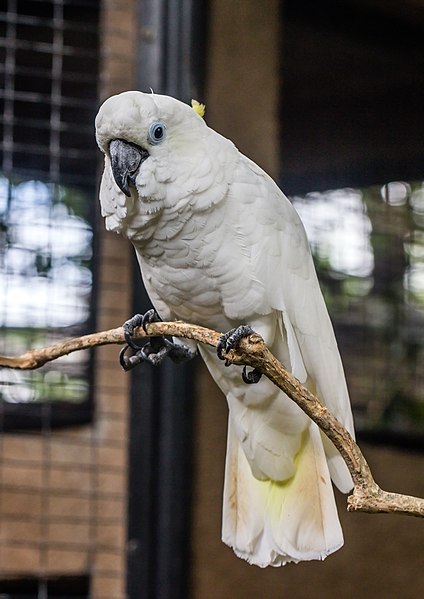The triton cockatoo is one of the more common members of the greater sulfur-crested family of cockatoos. They are large white birds, with sharply contrasting yellow crests that curve upward from the head. They are simply stunning to look at.
When you combine their beauty and brains with their playful antics, they are a crowd pleaser. This makes them the parrot most commonly used in the entertainment industry. Anyone familiar with the 1970s TV series, Baretta, will certainly remember Fred, the triton cockatoo who stole the spotlight week after week.
In actuality, the role of Fred was played by 4 different triton cockatoos. In 1975, Fred won the best actor Emmy, the first ever awarded to an animal! The triton cockatoo is a natural performer both in Hollywood and in our homes.

Despite the qualities that make it so easy to train, the triton is known for its unpredictable behavior. They can be sitting contentedly on your hand or wrist one minute and will pitch themselves forward into an upside-down position and bite at the underside of your arm – a manoeuver that is quite common with this species.
They, like all cockatoos, are prone to moods that turn on a dime, or seemingly so to owners who are not able to read their subtle body language. Life can be difficult with the Triton cockatoo.
3 Warning Signs to Help You Predict the Bite
Learning the triton cockatoo’s intricate body language is perhaps the greatest tool you will have in foreseeing behaviors. Every parrot gives telltale signals prior to acts of aggression. Some are just harder to see than others. These signs are all clear indications that your cockatoo is up to no good:
- Body positioning
If your cockatoo is directly facing you, with its feathers slick against its body, head lowered and body streamlined and pitched forward, you are about to be bitten. It is not a matter of “if”, but “when”. You will be wise to calmly pull yourself out of striking range. Take a non-offensive stance and speak in quiet tones to calm your bird. If you run, it will follow you – and they are remarkably fast on their feet.
- Eye shape
Cockatoos have dark eyes that prevent us from seeing the constriction of their pupils (often referred to as eye pinning). This is a sign of excitement in a bird – of either the good or bad variety. Without this visual clue, it can be hard to read a bird’s intentions. Cockatoos have wonderfully expressive eyes all the same. The eye shape of the happy and contented cockatoo is perfectly round. When that shape turns oval and squinty, it is the cockatoo’s version of a dirty look, sometimes referred to by cockatoo owners as the stink eye. Your parrot is getting angry with you and you need to determine and remove whatever it is causing it.
- Sudden stillness
Whenever your cockatoo stops what it is doing and stares instead at you, it is a contemplative action that typically turns out badly. Very often they will stop in mid-stride, one foot still in the air. It looks very comical, but trust me, it is not. It means that your bird is so unsettled by something that it has been stopped dead in its tracks. Whenever your cockatoo is singularly focused on a person or thing, it is necessary that you immediately divert its attention away. At this stage, fortunately, that is usually still possible.
With a triton cockatoo, there are joyously happy moments, balanced with occasionally unpredictable ones. It is all part of the nature of this species of bird. To maintain a great relationship with your bird, you must see that the good always outweighs the bad. Too many negative experiences, like those that result in biting, will cause trust issues that can be difficult to overcome without help.
